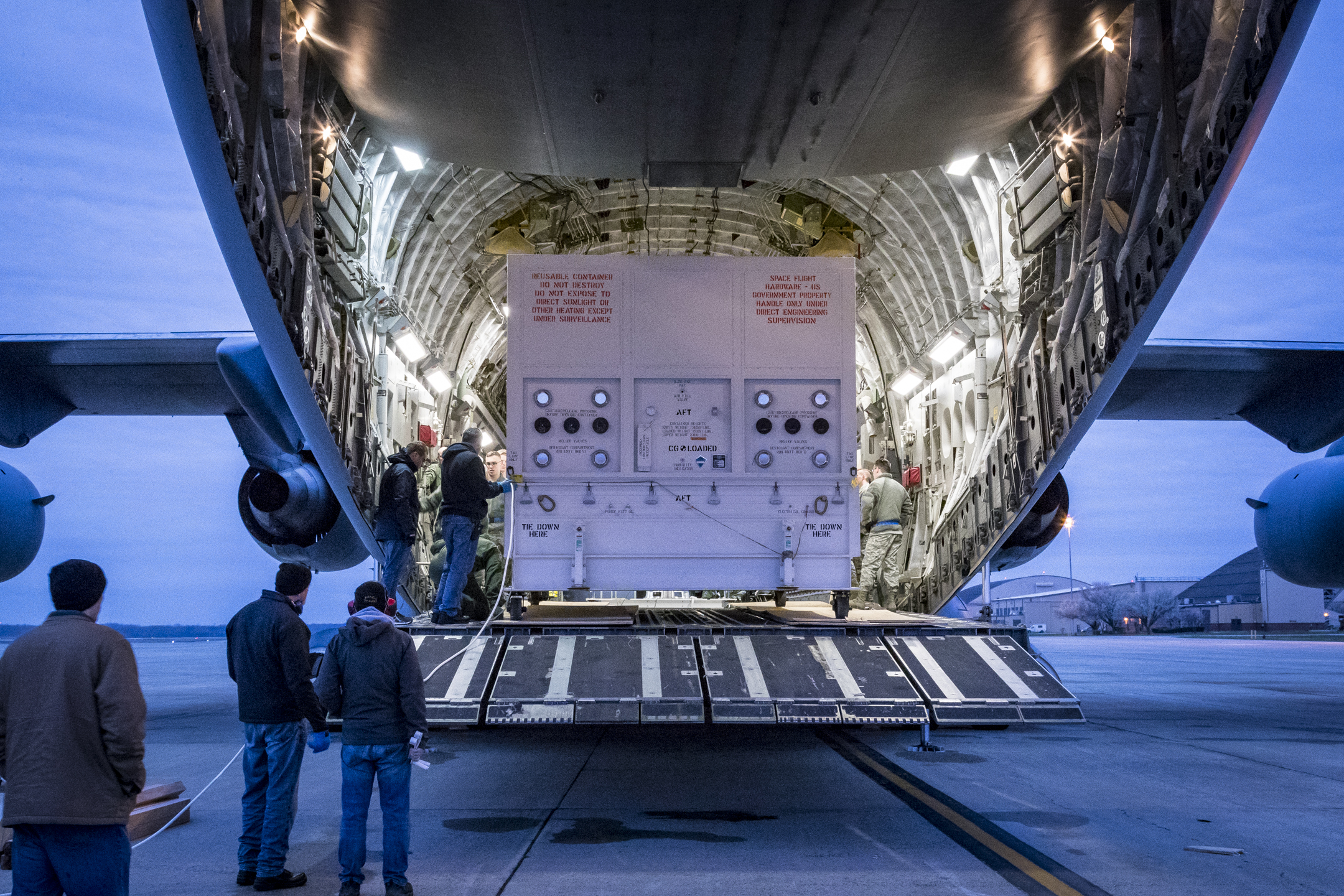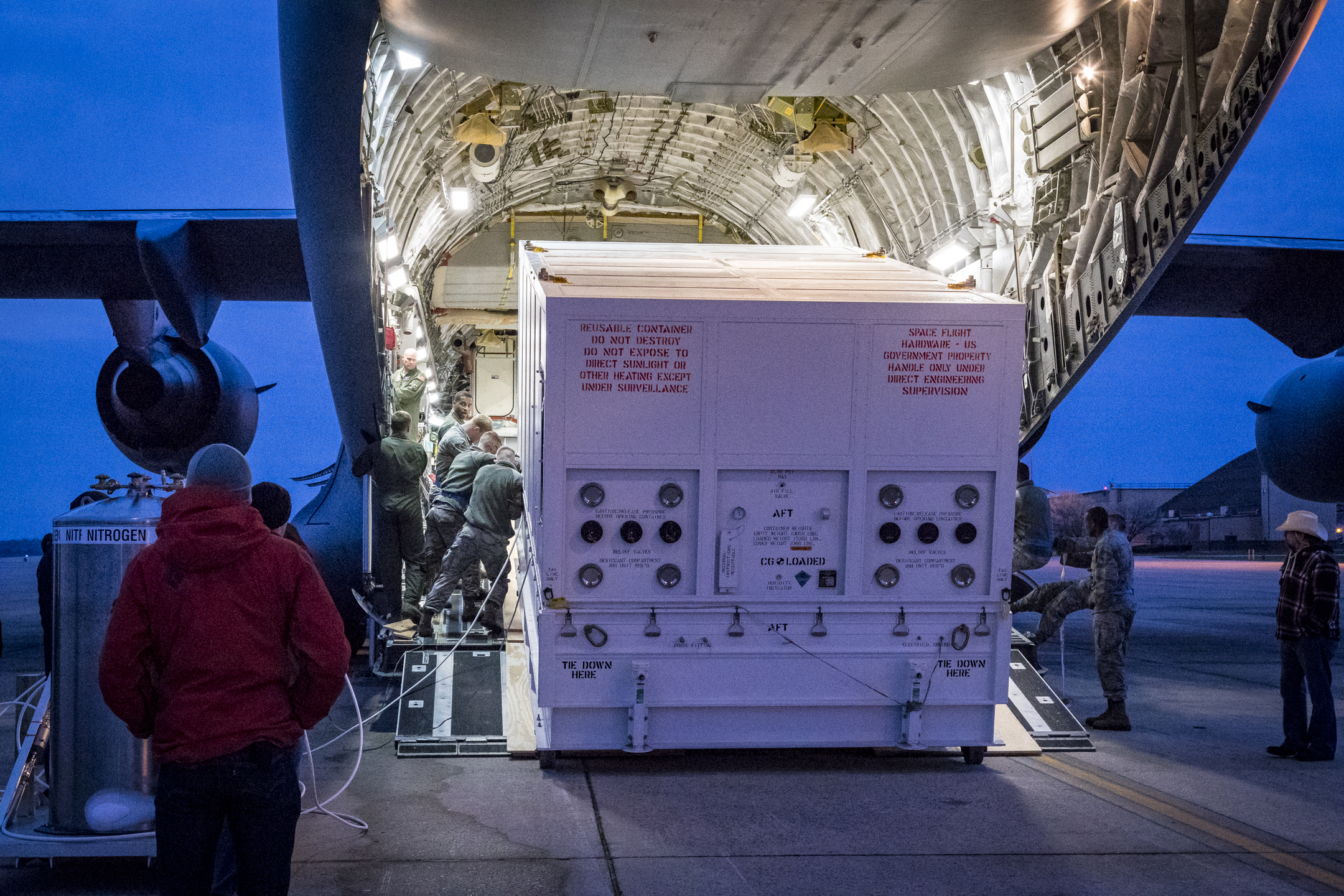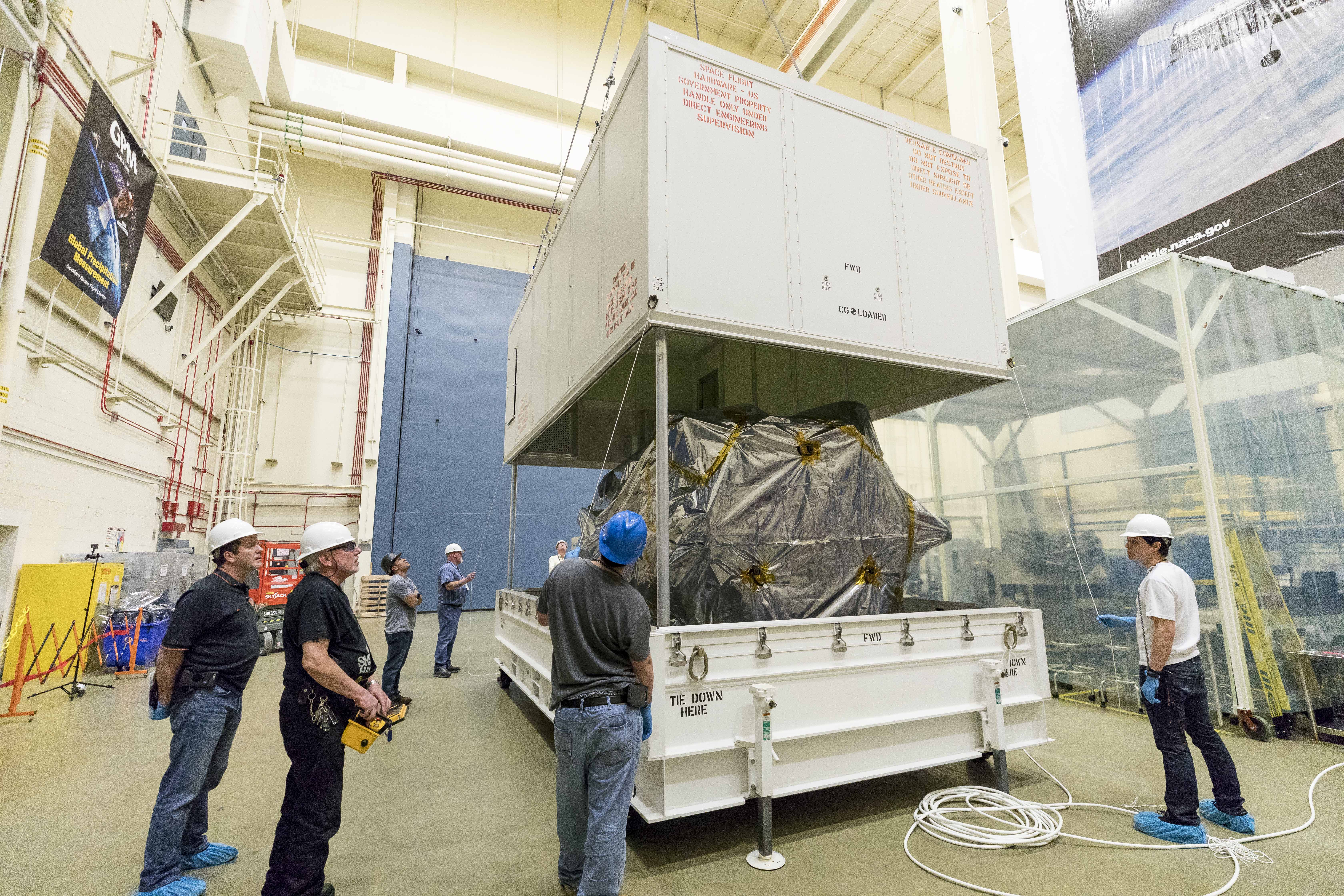NASA’s Mission to Touch the Sun Arrives in the Sunshine State
Posted on 2018-04-06 09:30:18Parker Solar Probe project scientist Nicky Fox of Johns Hopkins APL describes the spacecraft's journey to Florida and arrival at Astrotech Space Operations, the probe's new home before a scheduled launch on July 31, 2018 from NASA's Kennedy Space Center.
Credit: NASA/Johns Hopkins APL/Lee Hobson

NASA’s Parker Solar Probe is wheeled into position in a clean room at Astrotech Space Operations in Titusville, Florida, for pre-launch testing and preparations. On April 3, 2018, the spacecraft was transported from NASA’s Goddard Space Flight Center in Greenbelt, Maryland, to Joint Base Andrews by truck, then by a United States Air Force C-17 to Titusville.
Credit: NASA/Johns Hopkins APL/Ed Whitman
High-Res Image
Protected by special plastic sheeting, NASA’s Parker Solar Probe is wheeled into a clean room at Astrotech Space Operations in Titusville, Florida, for pre-launch testing and preparations. On April 3, 2018, the spacecraft was transported from NASA’s Goddard Space Flight Center in Greenbelt, Maryland, to Joint Base Andrews by truck, then by a United States Air Force C-17 to Titusville.
Credit: NASA/Johns Hopkins APL/Ed Whitman
High-Res Image
NASA’s Parker Solar Probe is carefully moved into a high-bay clean room facility at Astrotech Space Operations in Titusville, Florida, for pre-launch testing and preparations. On April 3, 2018, the spacecraft was transported from NASA’s Goddard Space Flight Center in Greenbelt, Maryland, to Joint Base Andrews by truck, then by a United States Air Force C-17 to Titusville.
Credit: NASA/Johns Hopkins APL/Ed Whitman
High-Res Image
NASA’s Parker Solar Probe is loaded aboard a truck after being flown to Space Coast Regional Airport in Titusville, Florida, on the morning of April 3, 2018, by a C-17 from the United States Air Force’s 436th Airlift Wing. The spacecraft was taken to Astrotech Space Operations, also in Titusville, for pre-launch testing and preparations.
Credit: NASA/Johns Hopkins APL/Ed Whitman
High-Res Image
NASA’s Parker Solar Probe is unloaded by forklift from the C-17 of the United States Air Force’s 436th Airlift Wing after arriving at Space Coast Regional Airport in Titusville, Florida, on the morning of April 3, 2018. The spacecraft was taken to Astrotech Space Operations, also in Titusville, for pre-launch testing and preparations.
Credit: NASA/Johns Hopkins APL/Ed Whitman
High-Res Image
Securely packed in its custom transport container, NASA’s Parker Solar Probe is unloaded from the C-17 of the United States Air Force’s 436th Airlift Wing after landing at Space Coast Regional Airport in Titusville, Florida, on the morning of April 3, 2018. After unloading, the spacecraft was taken to Astrotech Space Operations, also in Titusville, for pre-launch testing and preparations.
Credit: NASA/Johns Hopkins APL/Ed Whitman
High-Res Image
The custom shipping container holding NASA’s Parker Solar Probe is prepared for unloading from the C-17 of the United States Air Force’s 436th Airlift Wing after landing at Space Coast Regional Airport in Titusville, Florida, on the morning of April 3, 2018. The spacecraft was then taken to Astrotech Space Operations, also in Titusville, for pre-launch testing and preparations.
Credit: NASA/Johns Hopkins APL/Ed Whitman
High-Res Image
After landing at Space Coast Regional Airport in Titusville, Florida, on the morning of April 3, 2018, equipment is unloaded from the C-17 – from the United States Air Force’s 436th Airlift Wing – carrying NASA’s Parker Solar Probe. The spacecraft was later taken to Astrotech Space Operations, also in Titusville, for pre-launch testing and preparations.
Credit: NASA/Johns Hopkins APL/Ed Whitman
High-Res Image
The C-17 from the United States Air Force’s 436th Airlift Wing carrying NASA’s Parker Solar Probe taxis after landing at Space Coast Regional Airport in Titusville, Florida, on the morning of April 3, 2018. After landing, the spacecraft was taken to Astrotech Space Operations, also in Titusville, for pre-launch testing and preparations.
Credit: NASA/Johns Hopkins APL/Ed Whitman
High-Res Image
A C-17 from the United States Air Force’s 436th Airlift Wing, carrying NASA’s Parker Solar Probe, lands at 10:40 a.m. EDT at Space Coast Regional Airport in Titusville, Florida, on the morning of April 3, 2018. After landing, the spacecraft was unloaded and taken to Astrotech Space Operations, also in Titusville, for pre-launch testing and preparations.
Credit: NASA/Johns Hopkins APL/Ed Whitman
High-Res Image
A C-17 from the United States Air Force’s 436th Airlift Wing, carrying NASA’s Parker Solar Probe, approaches for landing at Space Coast Regional Airport in Titusville, Florida, on the morning of April 3, 2018. After landing, the spacecraft was taken to Astrotech Space Operations for pre-launch testing and preparations.
Credit: NASA/Johns Hopkins APL/Ed Whitman
High-Res Image
Sitting inside a custom-made protective shipping container, NASA’s Parker Solar Probe is loaded into a C-17 from the United States Air Force’s 436th Airlift Wing at Joint Base Andrews in Maryland in the early morning of April 3, 2018. From Joint Base Andrews, the spacecraft was flown to Titusville, Florida, where it was taken to Astrotech Space Operations for pre-launch testing and preparations.
Credit: NASA/Johns Hopkins APL/Jeffrey Fiske
High-Res Image
NASA’s Parker Solar Probe, inside a protective shipping container, is loaded into a C-17 from the United States Air Force’s 436th Airlift Wing at Joint Base Andrews in Maryland in the early morning of April 3, 2018. From Joint Base Andrews, the spacecraft was flown to Titusville, Florida, where it was taken to Astrotech Space Operations for pre-launch testing and preparations.
Credit: NASA/Johns Hopkins APL/Jeffrey Fiske
High-Res Image
Inside its protective shipping container, NASA’s Parker Solar Probe is loaded into a C-17 from the United States Air Force’s 436th Airlift Wing at Joint Base Andrews in Maryland in the early morning of April 3, 2018. From Joint Base Andrews, the spacecraft was flown to Titusville, Florida, where it was taken to Astrotech Space Operations for pre-launch testing and preparations.
Credit: NASA/Johns Hopkins APL/Jeffrey Fiske
High-Res Image
Parker Solar Probe – wrapped in protective plastic – is shown on March 29, 2018, as the lid is lowered onto its shipping container at NASA’s Goddard Space Flight Center in Greenbelt, Maryland. The spacecraft is shipped on its side to allow for more easy transport and to avoid height-related obstacles such as bridges. From Goddard, the probe was taken by truck to Joint Base Andrews in Maryland and flown to Florida aboard a United States Air Force C-17.
Credit: NASA/Johns Hopkins APL/Ed Whitman
High-Res Image